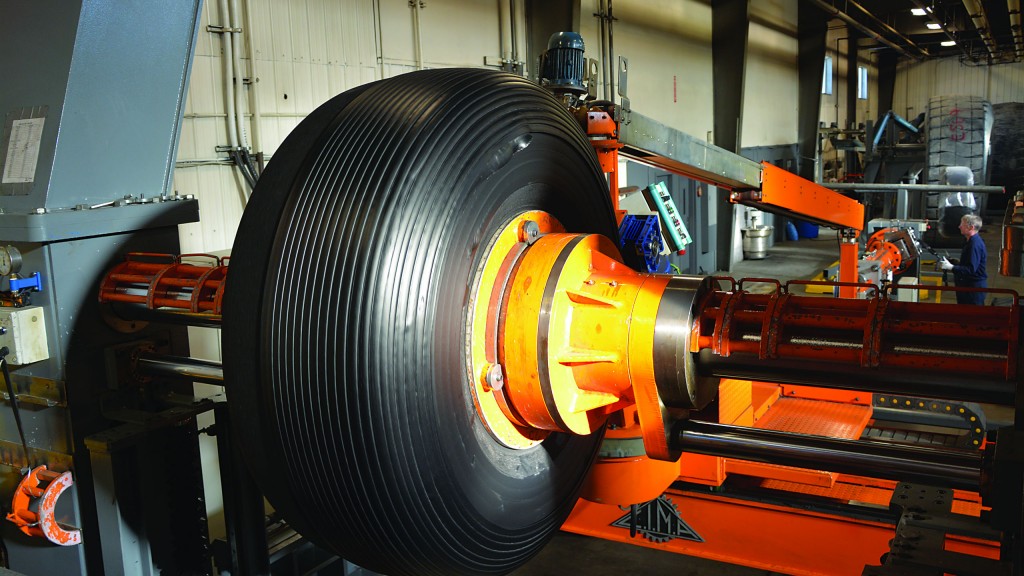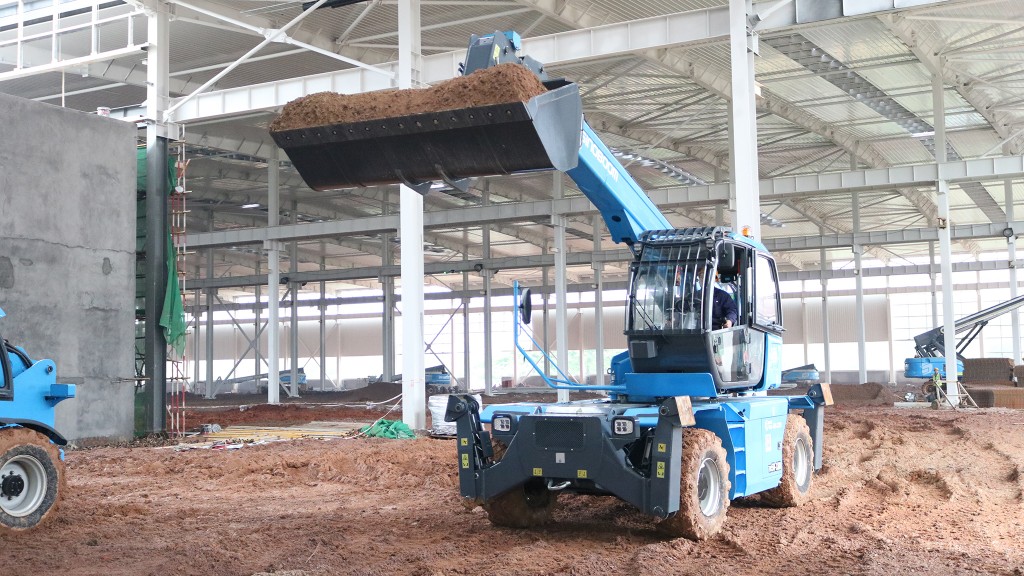The advantages of retread tires
Customized tread design and advanced materials are used to create a retread tire that can be better than the original

Today’s technology for retreading large tires has advanced far beyond where it began decades ago. Most tires on construction equipment and large trucks can be retreaded for much less than the cost of new tires, and the tread design and compounds used can be customized for specific applications, improving performance and longevity of the retreaded tire.
Retreading takes advantage of the technology that already exists under the tread in the highly engineered casing. “With retreading, the concept is to keep all of that technology intact while putting another layer of rubber over it, giving it another life,” said Norm Schmidt, Director of Retreading, Kal Tire. “It utilizes as much of the technology as possible.”
Retreading as a process has been around since the middle of the 20th century, and has grown in popularity and technical capability over that period. Kal Tire got into the retreading business in 1969 when the Vernon, B.C.-based company built a retread facility in nearby Kamloops. That facility continues to operate today, although the equipment inside has come a long way in complexity.
“The concept of retreading hasn’t changed a whole lot – we’re replacing rubber on an existing piece of rubber; it’s the technology that has changed, with automation and computerization of the equipment,” said Bert Jameus, Kal Tire retread plant manager. “I’d put us up against any new tire manufacturer and the technology they have.”
For Kal Tire, the combination of experience and technical advancement has made for strong relationships with industry partners, noted the company’s Vice President of Commercial Marketing, Cam Johnston.
“We have a customer locally in the mining business that we’ve been serving since 1969 – we know that customer, we know their equipment, and we know what their mine is like. Combine that experience with state-of-the-art, multi-million-dollar pieces of equipment, and we can make world-class tires that will in many instances outperform the tires that the world’s leading manufacturers make,” Johnston said.
The retreading process uses tire casings from a number of different sources. Customers may send their tires in when they reach a certain wear level, or the casings may be sourced by Kal Tire from other sources for retreading and resale, a process that speeds up tire replacement for their clients.
When used tires reach Kal Tire’s ISO 2015-certified retread facility, they are inspected to ensure the casing is still sound, then placed on a buffer, which strips the remaining tread off the casing. “That casing is basically the same as when Michelin or Bridgestone made it,” Johnston said.
Experienced employees then take the stripped-down casing and perform minor repairs and cleanup before the application of new rubber. Throughout the process, the tire is tracked by computer and each step recorded; at the same time, the expertise of Kal Tire’s staff and their knowledge of the customer’s needs guide the process.
“A big part of what we do to add value is to have guys like Bert go out and spend time with the customers so we understand the mine site or quarry, wherever the heavy equipment is operating,” Johnston said. “He may see that the tire needs a different compound, perhaps a cut- and chip-resistant compound, a different casing or a different tread for more traction or heat dissipation. This can really benefit our customers because the tire is going to perform better, more reliably and more safely for their applications.”
Once the casing is cleaned and repaired, the rubber compound is laid on by a machine that builds the new tread based on a computerized profile. From there, the tire may take one of two routes towards its final form, both of which involve time, heat and pressure to cure the raw rubber.
One method is to use an autoclave where tires are heated under pressure to ensure that the raw rubber cures and bonds firmly with the casing. Once these tires exit the curing process, they move to a machine that cuts the tread patterns using a computerized and automated process – either based on existing patterns or customized based on the individual needs of each customer.
Another method is to place tires into large molds that press the tread pattern into the tire while it is heated and compressed, providing a consistent design.
A final inspection is conducted to ensure the retreads are of the highest quality before they are shipped back to the customer or sold. The result is a high-quality tire that is essentially the same as brand-new, for a significantly lower cost.
Many casings can be used several times over before they can no longer be safely reused. Retreading instead of buying new can cut costs by hundreds or thousands of dollars per tire.
Schmidt offered an example of a rock truck tire that might cost $8,000 new, but a retread costs the customer $5,500. With six tires on a truck, the savings per set of tires in this case is $15,000 – and if those tires end up being retreaded four times, then the customer will save $60,000 over that set’s lifetime. For smaller trucks, that’s impressive. For larger trucks and equipment that use tires costing $100,000 or more, the savings is huge.
In addition, retreading also provides environmental benefits. Large OTR tires often wind up either in landfills or used on worksites as roadside barriers or for other uses when they’re worn out. Retreading puts the tire back to work, Johnston said.
“You are taking a perfectly good casing, and instead of grinding it up or putting it in a landfill, you’re able to use that thing – which consumes steel, oil and rubber – and make it work over and over again,” he said. “That’s something important to our customers; there’s a corporate social responsibility to reuse these tires.”
Aggregates business saves money with retreads
Walker Industries is one customer that has taken environmental responsibility to heart. The Ontario-based company has three core businesses – aggregates and construction, waste management and chemicals. A fifth-generation company that started out in the 1880s as stone cutters and moved into aggregates as automobiles became popular, Walker runs a large amount of equipment in its quarries.
“We’re a very capital-intensive business on the aggregates side, with a lot of heavy equipment and heavy iron. Tires are a significant part of that cost,” said Ken Lucyshyn, Executive Vice President of Aggregates & Construction, Walker Industries. “We watch the cost of our tires very closely.”
Darrin Rousselle, Corporate Account Manager, Kal Tire, said they help keep track of Walker’s tires and their needs.
“Walker’s fleet is on what we call our Tire Track system – every tire from cradle to grave is tracked, so we understand what their costs are by tire size and application,” Rousselle said. “That way we can offer the best solution for each application. And, with them being cost-conscious, we can make the right recommendations when tires need to be removed for retreading and put back into service.”
For Walker, ensuring the tires on their equipment operating in quarries can handle the conditions is important – but cost is also key. Retreads help meet both needs, according to Murray Arcaro, equipment manager.
“Because of the capital cost of the tires, we rely on retreads for certain applications. Retreads have come a long way – we can pretty well guarantee around 75 to 80 percent the lifetime of a new tire,” Arcaro said.
At the same time, the company avoids additional costs such as disposal fees, and keeps used tires out of the waste stream. For Walker, that is important – the company has embraced what it calls its EARTH First program of environmental stewardship, Lucyshyn explained.
“In our sustainability model we look at the economics of our business and see that retreads fit well into that program,” he said. “If we can divert those tires and extend their lives, then that’s great – less energy goes into retread tires than into purchasing new tires… the longer you can keep a tire in service, the less waste you have in the long run.”
Like many customers, Walker has built a valuable relationship with Kal Tire for its businesses, one that embraces a high level of confidence.
“We trust Darrin (at Kal Tire), and they help our operations,” said Ken Lucyshyn, Walker Industries. “We get good value, and when you think about the price of these tires, if we can extend the life of them even a little it helps.”



